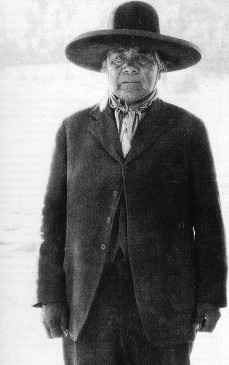Wovoka facts for kids
Quick facts for kids
Wovoka
|
|
|---|---|

Wovoka – Paiute spiritual leader and creator of the Ghost Dance
|
|
| Northern Paiute leader | |
| Personal details | |
| Born |
Quoitze Ow
c. 1856 Smith Valley, Nevada |
| Died | September 20, 1932 (aged 75–76) Yerington, Nevada |
| Resting place | Schurz, Nevada |
| Parents | Numu-tibo'o (sometimes called Tavibo; father) |
| Known for | Spiritual leader and creator of the Ghost Dance |
| Nickname | Jack Wilson |
Wovoka (born around 1856, died September 20, 1932) was a very important Paiute spiritual leader. He was also known by his English name, Jack Wilson. Wovoka started a special religious movement called the Ghost Dance. His name, Wovoka, means "cutter" or "wood cutter" in the Northern Paiute language.
Contents
Wovoka's Early Life and Teachings
Growing Up and Learning
Wovoka was born near Smith Valley, Nevada, around 1856. His birth name was Quoitze Ow. His father was Numu-tibo'o. From the age of eight, Wovoka worked for a rancher named David Wilson and his wife Abigail. They lived near Yerington, Nevada. The Wilsons gave him the name Jack Wilson. David Wilson was a strong Christian. Wovoka learned about Christian beliefs and Bible stories while living with them.
Special Abilities and Visions
Many Paiute people believed Wovoka had special powers. They said he could control the weather. Stories told that he could make ice fall from the sky in summer. He was also said to bring rain or snow to end dry spells. People believed he could light his pipe with the sun. He could even form icicles in his hands.
Wovoka said he had a powerful vision. This happened after he fell into a deep sleep. It was during a solar eclipse in 1889. In his vision, he saw that Native American people who had died would return. He also believed that white settlers and their ways would leave North America.
The Ghost Dance Message
To make this vision come true, Wovoka taught that Native Americans must live good lives. They also needed to perform a traditional round dance. This dance became known as the Ghost Dance. Wovoka's message included ideas from Christian beliefs. He spoke about Jesus Christ. He compared the future return of Native Americans to a biblical Judgement Day.
Wovoka talked about the living and the dead reuniting. He also taught that people should be peaceful and not violent. The Ghost Dance itself used images and symbols that showed these peaceful ideas.
How the Ghost Dance Spread
Experts have different ideas about when and how Wovoka had his vision. Some say it was in 1887 while he was chopping wood. Others say he woke from a two-day trance crying. No matter how it started, his message spread quickly. It went beyond his local Paiute community. It reached other Native American tribes, especially the Lakota.
The Ghost Dance and Wounded Knee
Spreading Across the West
The Ghost Dance movement became well-known. It was practiced by the victims of the terrible Wounded Knee Massacre. As the dance spread across the American West, different tribes understood Wovoka's message in their own ways. The Lakota Sioux, living on the Pine Ridge reservation, had a more forceful interpretation. They focused more on the idea that white people would leave.
Tensions and Conflict
The Lakota's version of the Ghost Dance did not directly ask for violence. However, it did show some anger towards U.S. government agents. Some historians believe that the Lakota's unique way of practicing Christianity caused problems. These problems led to tensions between white settlers and Native Americans. These tensions eventually led to the Battle at Wounded Knee.
U.S. officials often did not like the Ghost Dance. They sometimes reacted with hostility and violence. Wovoka himself never left his home in Nevada. He did not travel to spread the dance across the country.
Wovoka's Later Life and Legacy
Life After Wounded Knee
Wovoka was very sad about what happened at the Wounded Knee Massacre. Even so, he remained an important Native American leader. Around 1894-1896, he was reported to have been part of a carnival show in San Francisco.
In 1917, a government agent found Wovoka. The agent wanted to know if Wovoka was involved with the Native American Church. But Wovoka was living a quiet life. He worked as a traditional medicine man sometimes. He also traveled to events on reservations across the United States.
Death and Burial
Wovoka passed away in Yerington on September 20, 1932. He is buried in the Paiute Cemetery in Schurz, Nevada.
Wovoka in Popular Culture
Music and Movies
- The Native American band Redbone named their 1973 album Wovoka after him. The main song on the album is also called "Wovoka."
- In the 1971 movie Billy Jack, the character Billy teaches the Ghost Dance. His girlfriend, Jean, explains Wovoka and the dance. She even says that Christ appeared to Wovoka.
- The band Death Cult released a song called "Ghost Dance" in 1983. The lyrics mention Wovoka: "Wovoka had a vision, His words went far and wide - Save our once great nation, and dance the dance of Pride."
- In the 2007 film Bury My Heart at Wounded Knee, actor Wes Studi plays Wovoka.
- The American indie rock band The Dead Inklings wrote a song about Wovoka and the Ghost Dance called "Them Bones."
- The band Old Crow Medicine Show mentions Wovoka in their song "I Hear Them All." This song is from their album Big Iron World.
See also
 In Spanish: Wovoka para niños
In Spanish: Wovoka para niños
- Handsome Lake
- John Slocum
- Smohalla
- Native American temperance activists

